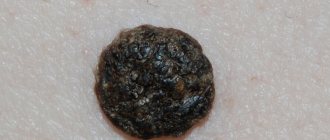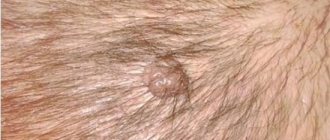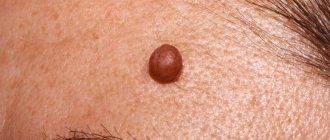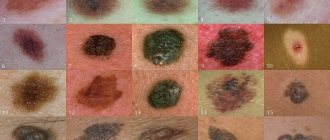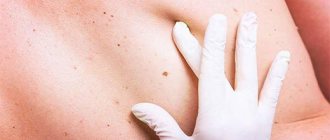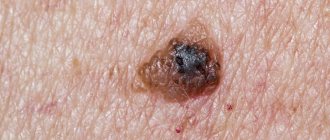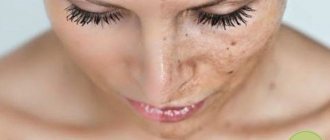Redness around a mole is a reason to be wary. It is often a sign of a disease of internal organs or the initial stage of oncology. Increased blood flow, pulsation, burning, pain, swelling indicate an inflammatory process that requires immediate attention to a dermatologist. Melanocytes - nevus cells, under the influence of unfavorable factors, activate or reduce the production of melanin pigment. The worst prognosis for changing nevus is melanoma (skin cancer). Nevi are genetically given to a person from birth. Owners of a large number of moles should pay attention to their condition. For any deformation, redness, irritation, or injury, you should immediately consult a dermatologist, especially in a child. Any symptom, even a minor one, can be associated with skin cancer.
Causes of redness
You need to regularly monitor the condition of birthmarks by conducting a monthly self-examination. A red halo around a mole signals a number of health problems. There may be an inflammatory process as a result of injury or burn. You should be wary if the redness was preceded by prolonged use of medications, or if there are chronic diseases in the acute phase. The formation of red spots around a mole can be caused by solar radiation, abuse of tanning beds, due to thermal, chemical burns of the skin, which leads to malignancy - the degeneration of a nevus into malignant melanoma.
External factors
A red spot and bleeding may appear due to mechanical damage to the nevus by clothing. Hanging warts (an acquired phenomenon) on the back, in the armpits, waist, and elsewhere are injured by the edges of clothing and cause inconvenience to the owner. When touched, the papilloma can begin to bleed, and each subsequent injury causes additional damage to the tissue. It is better to remove such formation. Accidental cuts, bruises and bruises in the area of the nevus disrupt the structure of the dermis and can lead to pathological degeneration.
Ultraviolet light is a skin killer. The radiation activity of the sun is high, cases of deep burns have become widespread. Ultraviolet light can burn the top layer of skin - the epidermis, and reach the deep layers of the dermis, destroying connections at the intercellular level. You need to know that the sun is most active from 12 to 15 hours. It is recommended to sunbathe in the morning and evening, avoiding the midday period, and be sure to use a protective cream to avoid burns. You should be wary of solariums - artificial tanning has a negative effect on the skin and leads to changes in the structure of the epidermis. People prone to developing age spots should sunbathe with extreme caution. Damage to areas of skin with a mole due to frostbite or burns leads to disruption of metabolic processes. Risk factors and external causes of redness around a mole are:
- chemical damage by toxic substances;
- persistent dermatitis;
- skin allergies.
Internal factors
Internal factors include chronic diseases that lead to weakened immunity:
- taking loading doses of antibiotics;
- sluggish chronic infections;
- undergone surgical interventions.
Hormonal imbalance during pregnancy, menopause, adolescence or while taking hormonal drugs, dysfunction of the thyroid gland, adrenal glands. Stress and imbalance of the nervous system, psychosis, insomnia, anxiety. Fungal infection of the skin and mucous membranes, especially advanced forms - all of the above factors are causes that can provoke malignant formations on the body.
Internal factors
Redness of a mole can be caused by internal reasons:
- impaired metabolic processes;
- allergic reaction;
- hormonal disbalance;
- failure to comply with basic rules of personal hygiene;
- insufficient or excessive amounts of vitamins in the body;
- fungal skin infections;
- malfunctions of the immune system;
- skin diseases;
- problems in the cardiovascular system.
Each of the above problems must be dealt with comprehensively, only this will help quickly and effectively eliminate redness and avoid additional problems.
Is the condition dangerous?
Redness and inflammation of a mole may not be dangerous, but consultation with a doctor is required. The dermatologist will prescribe a product to care for the inflamed formation (streptocide, alcohol tincture of calendula or anti-inflammatory ointment). If a pathology is suspected, the doctor conducts an examination using a dermatoscope; if the process is benign, he will recommend leading a certain lifestyle.
The appearance of a halo around a mole may be a signal of fragility of blood vessels, which will subsequently lead to cardiovascular diseases and even hyperemia. Timely examination reveals the problem. Vitamin therapy is prescribed.
The doctor may detect inflammation of the skin under the red spot - degeneration of epidermal cells. Impaired blood supply leads to diseases of the dermis. Redness of a mole may indicate incipient atopic dermatitis or the consequences of an allergic reaction. Timely consultation with a doctor contributes to the early detection of the irritant and prevents its harmful effects.
The appearance of a red rim around the nevus may indicate the beginning of degeneration into a neoplasm - skin cancer. Melanoma begins to hurt at the last, fourth stage. Only external changes are a signal of serious pathology. Diagnosis of melanoma involves additional tests, referral to an oncologist, and taking samples for histological examination. Surgical removal of a malignant nevus will become the basis of treatment.
Why do moles become inflamed?
The main causes of inflammation of moles can be:
- Ultraviolet rays as a result of prolonged exposure to the sun contribute to cell changes, which is very important for people with fair, sensitive skin and those with freckles.
- Any damage in the form of scratches, cuts or other injuries can cause infection to enter the mole. If the pigmented spot begins to swell and redden, pain occurs, itching, and peeling appear - this is a serious reason to contact an oncologist.
- Obvious redness of the skin around the pigment spot and the occurrence of bleeding from the nevus indicates that, as a rule, in such cases, removal of the neoplasm is indicated.
Whatever the reasons why the inflammatory process of the birthmark was started, it is imperative to obtain the recommendations of a specialist for further treatment of the nevus.
Associated symptoms
In addition to redness around the nevus, accompanying symptoms occur:
- pain when pressing;
- throbbing with pain;
- bleeding;
- itching;
- asymmetrical edges;
- fast growth;
- color change (uneven coloring, white edging, black or light dots on a pink background, versatility of color);
- swelling on one or more sides, redness of the skin around the mole;
- cracks on the surface, sometimes bleeding, the surface peels off.
Many of the symptoms are signs of skin cancer. Friction, microcracks, infections, abuse of the sun and chemicals can contribute to the active and progressive degeneration of a mole into melanoma. Dr. Komarovsky encourages you to contact a medical facility if the nevus deviates from the norm.
Symptoms of malignant moles
Any moles change over time, and a typical nevus has a uniform color, clear boundaries that separate the “body of the formation” from the surrounding skin, and the size does not exceed 2 cm. Most people have approximately 10-45 such moles on their body. They continue to appear until the age of forty, some disappear with age. Atypical nevi differ from ordinary nevi in their appearance.
Typical nevi
There are several signs that may indicate the beginning of the transformation of a mole into an oncological formation:
- Presence of asymmetry. If you visually draw a line in the center, for a typical mole both halves located on both sides will be exactly the same in shape. Cancer cells always divide unevenly, so lack of symmetry is the first sign of malignancy.
- Border shape. The edges of a malignant formation are always uneven, torn, and similar to teeth.
- Dark color. Discoloration is the first sign of malignancy. If a mole suddenly darkens, if dark inclusions appear in its structure, making the surface uneven, this is a reason for concern.
- Increase in diameter. Melanoma increases in size very quickly; it grows, as they say, “before our eyes.”
Benign nevi continue to be the same over time, malignant ones change, taking into account all the signs listed above.
Changing the color of moles
When to see a doctor
If you observe one or more dangerous symptoms, consult a doctor immediately. If the mole turns red and starts to itch, watch it for 1-2 days. The redness may go away on its own. If there is no improvement or the situation is aggravated by burning and pain, contact a medical center for diagnosis. The reason to consult a doctor is a nevus that causes inconvenience when dressing. Regular rubbing with the collar of a shirt, underwear, touching with a comb or razor when the formation is located on the head, face and neck leads to injuries.
There are a number of methods to remove a mole. Laser removal is one of the safe, painless and fast methods. To excise a dangerous formation, contact a medical institution for diagnostics and then select the optimal removal method. You should not self-medicate. The use of streptocide, brilliant green, iodine, and hydrogen peroxide not as prescribed by a doctor can be hazardous to health. You need to see a doctor, even if the nevi do not bother you. Getting checked once a year can prevent serious health problems. An annual examination is especially recommended for people with a large number of spots on the body. This way you will be confident in your own health and will receive the necessary treatment for the tumor under the supervision of a specialist.
What to do if a mole has darkened?
Let us remind you once again that the first thing you need to do is contact a medical clinic, a qualified specialist. But darkening of a mole in itself is not a sufficient reason for making a diagnosis.
The patient will be asked to undergo several diagnostic procedures. First, a visual inspection by a specialist. Then - tests (skiascopy, dermatoscopy). If the clinical picture is controversial, then an additional biopsy is prescribed.
Causes of redness around a mole
The causes of redness around a mole can be divided into three groups:
- Mechanical damage. Redness of the skin around the mole is caused by the fact that it was simply pinched with nails, jewelry or other objects. Very often, moles are located in areas where there is a high risk of injury. For example, those located in the neck area can be pinched with fingers, jewelry; a very hard collar or even a tag on clothing can damage the delicate surface of the mole.
- Chemicals. A mole is one of the sensitive and most vulnerable areas on the human body. Therefore, she may react negatively to cosmetics or medications with aggressive components. You must immediately stop using the product or carefully ensure that it does not come into contact with moles and the skin around them.
- Degeneration of a mole into a malignant tumor. There are many types of melanomas, from inactive to fast-growing. In half of the cases, the skin around the mole turns red. This means that some inflammatory processes are occurring inside it, but are not yet completely noticeable from the outside.
A mole can react to any of the listed factors, regardless of its size, location on the body or how long ago it was formed. Some people mistakenly believe that only larger moles have a risk of degeneration. This can be explained by the fact that on large moles the changes are more noticeable.
[4], [5], [6]
Symptoms of redness around a mole
What diseases are preceded by redness of the skin around a mole? These can be symptoms not only of diseases, but also of adverse effects on the skin. Redness may occur because:
- You have been exposed to the sun's rays for too long. The sun may cause slight inflammation of the skin around the mole. Basically, this can happen if you ignore doctors' warnings and are in the open sun from 11 am to 6 pm. At this time, the rays are most harmful and carry a lot of solar radiation. Since moles are very sensitive, they can react immediately. In some cases, the mole itself may change color because ultraviolet radiation affects the color of the pigment.
- A benign tumor passes into the malignant stage. This can happen again due to excessive sun exposure. Heredity is of great importance. If a mole is degenerating and is in an intermediate stage, it is easy to determine it yourself. The skin around it will turn red, and the mole itself will increase in size. Flat moles become more convex. Also, the outlines of the mole become not even and clear, but blurred with “ragged” edges.
In any case, you should not put off visiting a doctor or self-medicate without an accurate diagnosis. With the wrong approach, you can only harm the tumor, accelerating the course of the disease.
Redness around the mole and swelling
Redness and swelling around the mole can occur in several cases. If you hit a mole with a sharp object or otherwise injure it, it will certainly react this way. Swelling appears because the body immediately reacts to damage and local hyperemia occurs in that area. Redness is a natural skin reaction. The skin may turn red even with slight friction.
The second reason for redness and swelling is changes that occur under the skin at the location of the mole. Most often these are changes of a negative nature. You need to observe the mole for some time. If you notice the slightest change in color or size, contact your oncologist immediately.
Gradually, after redness and swelling, pain, itching and a constant feeling of discomfort may be added. The sooner you contact specialists, the easier and more painless it will be to perform the operation (if necessary).
Several simple and harmless ways to relieve redness and swelling: sprinkle with Streptocide, wipe with alcohol or calendula tincture, anoint with antibacterial ointment with zinc or salicylic acid. If the redness does not go away, and the feeling of discomfort has become even stronger, the mole cannot be treated on its own.
Do black moles need to be removed?
For no reason, doctors do not recommend removing even black moles. After all, almost every person has them on their leg or arm, on the genitals of both women and men. Benign neoplasms on the skin are removed if they are constantly rubbed and injured by clothing , shoes, and jewelry.
In cases of sudden changes or itching, you need to go to the doctor and if melanoma is suspected, it will only be removed surgically, and will also be taken for a biopsy. If there are cancer cells in it, long-term treatment and chemotherapy for melanoma follows.
And if the nevus is benign, even black or with dots, then it can be removed using different methods:
- Laser, slightly painful, but without blood and subsequently there will be no scars.
- Cauterization with electric current (electrocoagulation) also hurts a little, but without blood, after which a crust forms.
- Removal by cold (cryodestruction), after the procedure a crust appears, which will fall off over time, leaving healthy skin.
- Surgical, the mole with the skin around it is cut out, then a sterile bandage with antibacterial ointment is applied, and after the wound heals, a scar remains.
There are many fans of treatment with folk remedies, and the search engine will give you a wide variety of methods for getting rid of black moles, for example, tying with thread, making various lotions, burning with acid, celandine and other tips. But under no circumstances should this be done! After all, you can independently start an irreversible process of cancer, which can lead to rapid death. It is better to immediately contact specialists, namely doctors in the hospital, and not some dubious specialists in salons who provide mole removal services without any medical education.
Complications and consequences
The consequences of redness around a mole can be very different. If she is red from too much sun exposure, this will lead to excess melanin accumulation. A benign mole can develop into a malignant one. Also, a rash sometimes appears on the reddened area around the mole or inflammation spreads to neighboring areas.
If doctors have diagnosed the first stage of melanoma, then the consequences are surgical and non-operative treatment. If the formation is detected at the first stage, it can be treated with ultrasound waves, chemotherapy and radiation. If the patient consults an oncologist, then in most cases the treatment consists of a whole range of procedures, including surgery. You will definitely need to cut tissue near the mole.
The consequences of redness around a mole can also include the following changes in lifestyle: minimal sun exposure, a ban on visiting solariums, etc., which can trigger the re-formation of inflammation or a malignant tumor.
A mole has swollen and changed color, what does a bad growth look like?
Melanoma is a skin disease that looks like a mole. It is a malignant tumor and arises from melanin pigment cells. Unfortunately, melanoma has the ability to grow quickly and affect the human body.
She looks no less nice than you can tell about her. Moreover, it cannot be immediately determined, especially if a person is not attentive to his health. All people can develop melanoma, but some are less likely to get melanoma than others.
It is determined by its species characteristics.
- A spot or raised mole is larger than 1 cm in size.
- The formation will develop from brown to black.
- The spot or mole is actively growing. The largest melanomas can reach 20 centimeters or more on any part of the body.
- Over time, the mole develops asymmetry and goes beyond its boundaries.
- It has a very soft or hard structure.
- When touching the affected area, pain is felt.
- It bleeds, burns, and hair falls out from the mole site.
The most terrible disease, the symptom of which is inflammation of a mole, is CANCER . Only an oncologist can make such a diagnosis after passing certain tests. The most important thing is to start treatment on time and believe in its success.
Remember! There is nothing more important than our health. Any deviations, be they external or internal, require research and, if necessary, treatment. It is important to study and take care of yourself throughout life . Thus, it will be possible to avoid many diseases and be confident in the future. Don’t put off your health “for later”, take care of it every day. Improve the quality of your life and the lives of those around you!
- Agata Muceniece captivated fans with a deep neckline and a mole on her chest
- TV presenter Aiza Anokhina accidentally posted a photo of her genitals online
- Dr. Myasnikov explained how to distinguish moles that can develop into melanoma
- From a mole to a tumor - one step, or the first 6 “bad” symptoms
- Avia.pro: American forces tried to attack Russian military in Syria
- What do we know about the biography of Naila Asker-zade
- Doctors have listed the early symptoms of the most common type of cancer in Russia
- New details have been revealed about the incident involving the ramming of a US armored car by a Russian armored personnel carrier in Syria
- The general appreciated Georgia's promise to regain South Ossetia
- The chief oncologist of the Ministry of Health named the first signs of skin cancer
- From a mole to a tumor - one step, or the first 6 “bad” symptoms
- An oncologist named the color of a mole that signals the danger of cancer development
Become a member of the CLAN and every Tuesday you will receive the latest issue of “Arguments of the Week” with a discount of more than 70%, along with exclusive materials not included in the newspaper. Get premium access to a library of the most interesting and popular books, as well as an archive of more than 700 published issues for FREE. In addition, you will have the opportunity to benefit from free legal advice from our experts for a whole year.
- Enter your email address, then select any convenient payment method for your annual subscription
- Scan the QR. In the Sberbank Online application that opens, enter the annual subscription cost (490 rubles). Then send the confirmation code by email
Or
Diagnosis of redness around a mole
Diagnosis of redness around a mole consists of a general examination and instrumental diagnosis. A general examination is carried out by an oncologist. He will be able to immediately determine whether the mole is dangerous. You can also conduct an examination at home; you need to check it according to the points in the “Complications” section.
Instrumental diagnosis consists of procedures such as biopsy, histological examination and dermatoscope. With the help of such modern methods, it is possible to accurately diagnose whether a mole is malignant.
A biopsy is a procedure performed to identify cancer cells in the tissue underneath a mole. A small section of tissue is made. This procedure is safe, since if the mole is not dangerous, it can be treated without surgery.
A dermatoscope is a medical microscope that can make the surface of a mole transparent. The doctor will be able to see what is happening inside the mole, what processes are developing there and how the disease progresses. Thanks to this, you can more accurately prescribe treatment or surgery.
Histological examination - a part of the inflamed mole is taken for analysis. If there are cancer cells there, it becomes immediately visible. This method was one of the first that oncologists began to trust.
An indispensable part of the diagnosis is also a blood and urine test. The body reacts to a malignant mole by increasing the level of white blood cells, decreasing hemoglobin and other obvious changes.
[14], [15], [16], [17], [18], [19]
Mole removal methods
Modern medicine has many ways to solve the problems of an inflamed nevus, and all of them involve removing the formation. The most commonly used:
- Surgical method of removal. The operation to excise the body of the mole is carried out with a scalpel under local anesthesia and lasts no more than half an hour. After the manipulation, the removed material is sent for biopsy to confirm the benignity of the formation. However, this method is not used very often. Possible post-operative scars and scars.
- Laser method of removal. A modern method of influencing neoplasms, which allows you to remove a nevus completely painlessly within a few minutes. The advantages of removing moles with a laser beam include the bloodlessness of this technique, a clear cosmetic effect (does not leave scars), short duration of manipulation, and rapid healing (up to two weeks).
There are other methods for removing moles: electrocoagulation, cryodestruction, radio wave method. An experienced specialist, if necessary, will select the optimal method of mole removal for each patient individually.
Treatment of redness around a mole
Redness around a mole can be removed with medications that are sold in pharmacies or folk remedies. It is better to choose a method that does not have side effects or negative reviews. When choosing an ointment or any other medicine in a pharmacy, it is advisable to look at the instructions and composition. Choose herbal preparations or those with ingredients to which you are definitely not allergic. Traditional recipes use harmless herbs and ingredients. The only downside can be a weak effect and a longer course of treatment.
Treatment must be carried out as indicated in the prescription or instructions. A stronger dose can only cause complications. It is best to consult a doctor who can help you choose the right dosage.
If a mole degenerates into a malignant tumor, treatment can be carried out using radiation and chemotherapy, electric current, and biopsy. In more complex cases, surgical intervention cannot be avoided. When choosing a treatment method, start with one that is safer and harmless to the body. Otherwise, you risk treating the inflammation of the mole and getting another complication.
Why does redness occur around a mole after removal?
If you have removed a mole surgically, there will certainly be a small mark and redness left in this place. This is a natural reaction of the body to interference in its coordinated work. Redness at the site of mole removal may last 2-3 weeks. Also, in most cases, a mole leaves a small wound with a crust over it.
After removal of a mole, redness indicates that an active process of healing and formation of young skin is occurring. When the crust falls off, a small light spot will remain in its place, which will gradually become the same color as the skin. Depending on the restoration ability, the size of the mole and the type of removal, a scar remains. In some cases it is very noticeable and requires additional processing.
Also, redness after removal of a mole may indicate that an infection has occurred or the operation was performed poorly. When removing a mole, you must completely remove the root itself, otherwise it may grow back. Redness that does not go away for a long time may indicate this.
What to do if redness appears around a mole?
The main thing is not to start self-medicating without establishing the exact cause of the redness. Redness indicates that the mole has been damaged mechanically, chemically or by ultraviolet radiation. Now processes of restoration or rebirth are taking place in it.
What dermatologists-oncologists recommend doing if redness appears around a mole:
- Conduct self-diagnosis. Basically, you need to determine whether the mole has changed in appearance or not.
- Observe the condition of the mole for 1-2 days.
- Be sure to consult a doctor.
- If redness does not go away after 3-4 days, get tested at a medical facility.
If redness appears, but the mole does not hurt and has not changed in appearance, you can try treating it with celandine, calendula, or an anti-inflammatory cream without chemical additives. With simple irritation from mechanical and chemical effects, the redness will quickly go away. If these measures do not help, do not try other methods - seek help from specialists. A mole can develop into melanoma, which is considered one of the most aggressive types of cancer.
Medicines
To self-treat redness around a mole at home, you can only use a couple of medications. They are guaranteed not to cause harm.
- Streptocide. The simplest, most affordable and effective tablets. They can be bought at any pharmacy and are very inexpensive. Take a few Streptocide tablets, grind them into powder, and then sprinkle on the inflammation. Hold it like this for a while. You should not wrap or cover a mole. It is also not recommended to sprinkle Streptocide on top of another drug or ointment if you have previously treated inflammation with it.
- Medical alcohol. If the pharmacy does not have it, you can buy an alternative remedy - Septil. Treat the redness with alcohol, do not bandage or cover with adhesive tape. Wipe several times a day until the redness goes away completely.
- Tincture of calendula. It will relieve inflammation or irritation, if any. It should be used in the same way as medical alcohol.
- Triple antibiotic ointment. Bartel drugs (Polymyxin B sulfate + neomycin sulfate + bacitracin). An analogue may be Levomekol. The drug is absolutely harmless, but after several applications to the redness, the result will be noticeable. Zinc and salicylic acid quickly relieve inflammation and redness, as well as swelling.
Symptoms of inflammation of moles
photo inflammation of the mole
Responding in a timely manner to the process of inflammation of the nevus that has begun is one of the main facts of complete recovery. Therefore, it is so important to know the signs of the initial stage of the inflammatory process.
- Particular attention should be paid to neoplasms that exceed 0.5 cm in size and have pronounced pigmentation with peculiar accentuated edges.
- An overly smooth surface of a birthmark and sudden changes in size, color, or shape are a serious reason to consult a specialist.
- Closer attention should be paid to the symptoms that characterize the degeneration of moles, which include:
- Uneven coloring of the birthmark.
- The absence of a pattern or its disruption on the surface of the pigment spot, the appearance of peeling.
- Manifestations of the inflammatory process in the tissues around the tumor (severe redness of the skin).
- Change in color characteristics: from light brown to rich dark color (black).
- The appearance of black dots (nodules of various sizes), localized in the form of a ring located along the contour of the birthmark.
- Blurred outlines of a birthmark and changes in its configuration indicate pathological changes in cells.
- A significant increase in size, blurred boundaries and obvious compaction of the body of the mole.
- Detection of small nodules (with elements of necrosis) at the base of the tumor.
- The appearance of a burning sensation, tingling sensation, or itching in the area of the birthmark requires urgent consultation with a professional.
- Hair falling out from the pigmented surface of the mole indicates unfavorable changes in the skin cells of the tumor.
- Various types of lesions and cracks that appear on the surface of a mole should cause undoubted warnings.
- Sudden, sharp changes in the birthmark, leading to its suppuration and bleeding, are a reason for the necessary examination.
As the mole deepens into the dermis, it begins to protrude slightly above the surface of the skin. Such changes may not have undesirable consequences. Concern should be caused by a sharp change in the color, size and contours of the tumor. When the first signs of such transformations appear, in order to avoid serious health problems, you need to seek help from a specialist.
Prevention
To prevent redness of the skin around a mole, you must follow simple rules:
- You can sunbathe under the open sun only in the morning and evening hours, while it is not so strong. At lunchtime it is better to be in the shade. This is especially true for those people who have many moles or have very fair skin.
- Use protective sun creams.
- Do not visit solariums. Artificial sun is very dangerous for the skin. It is this that provokes many melanoma formations. Frequent visits to the solarium and excessive stay there have a detrimental effect on moles; they can become inflamed and gradually degenerate into melanomas.
- Periodically examine moles on your body.
- Do not ignore any discomfort or discomfort in the area of the mole, especially if you have previously had melanoma or suspected melanoma.
The best way to prevent skin redness is good protection from direct sunlight. To do this, avoid harmful ultraviolet radiation, wear long sleeves, hats with large brims, sunglasses with dark lenses, and apply sunscreen with a high solar filter to your skin.
[20], [21], [22]
Why did the mole darken?
Changes in nevi lie in the action of certain factors on them. Can a mole darken? Yes, and it’s all about the reasons that affect the activity of melanocytes (and, accordingly, the amount of pigment they produce). This is the following:
- UV rays. Ultraviolet light most contributes to the accumulation of melanin in cells. That's why we get a chocolate tan under the rays of the sun and solarium lamps. If you periodically spend a long time in the sun, you may notice that the mole has darkened along with the skin (sometimes the nevus becomes almost black, black spots appear on it). Experts advise protecting marks from direct exposure to UV rays - using protective equipment, covering yourself with clothes, and not sunbathing in the sun from 11 a.m. to 4 p.m. If you have a lot of moles on your body, then it is better to avoid going to the solarium.
- Changes in hormonal levels. This condition also affects the production of melanin. Therefore, nevi can darken during adolescence, pregnancy and menopause in women. The darkening of nevi is one of the external signals that the body is being rebuilt and there is an imbalance in its systems.
- Damage. A mole may well change its color due to mechanical impact on it or injury. The cause could even be constant friction against clothing.
